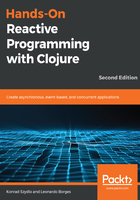
First-order FRP
The most well-known reactive language in this category is Elm (see http://elm-lang.org/), an FRP language that compiles to JavaScript. It was created by Evan Czaplicki and presented in his paper Elm: Concurrent FRP for Functional GUIs[3].
Elm makes some significant changes to higher-order FRP.
It abandons the idea of continuous time and is entirely event-driven. As a result, it solves the problem of needless recomputation, which was highlighted earlier. First-order FRP combines both behaviors and events into signals, which, in contrast to higher-order FRP, are discrete.
Additionally, first-order FRP allows the programmer to specify when the synchronous processing of events isn't necessary, preventing unnecessary processing delays.
Finally, Elm is a strict programming language, meaning that arguments to functions are evaluated eagerly. This is a conscious decision, as it prevents space and time leaks, which are possible in a lazy language such as Haskell.